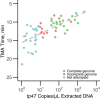Genomic Epidemiology of Treponema pallidum and Circulation of Strains With Diminished tprK Antigen Variation Capability in Seattle, 2021-2022
- PMID: 37769216
- PMCID: PMC10938213
- DOI: 10.1093/infdis/jiad368
Genomic Epidemiology of Treponema pallidum and Circulation of Strains With Diminished tprK Antigen Variation Capability in Seattle, 2021-2022
Abstract
Background: The incidence of syphilis continues to increase in the United States, yet little is known about Treponema pallidum genomic epidemiology within American metropolitan areas.
Methods: We performed whole-genome sequencing and tprK deep sequencing of 28 T. pallidum-containing specimens, collected mostly from remnant Aptima swab specimens from 24 individuals from Seattle Sexual Health Clinic during 2021-2022.
Results: All 12 individuals infected with Nichols-lineage strains were men who have sex with men, while a specific SS14 cluster (mean, 0.33 single-nucleotide variant) included 1 man who has sex with women and 5 women. All T. pallidum strains sequenced were azithromycin resistant via 23S ribosomal RNA A2058G mutation. Identical T. pallidum genomic sequences were found in pharyngeal and rectal swab specimens taken concurrently from the same individuals. The tprK sequences were less variable between patient-matched specimens and between epidemiologically linked clusters. We detected a 528-base pair deletion in the tprK donor site locus, eliminating 9 donor sites, in T. pallidum genomes of 3 individuals with secondary syphilis, associated with diminution of TprK diversity.
Conclusions: We developed an end-to-end workflow for public health genomic surveillance of T. pallidum from remnant Aptima swab specimens. tprK sequencing may assist in linking cases beyond routine T. pallidum genome sequencing. T. pallidum strains with deletions in tprK donor sites currently circulate and are associated with diminished TprK antigenic diversity.
Keywords: Treponema pallidum; tprK; genomic epidemiology; immune evasion; syphilis.
© The Author(s) 2023. Published by Oxford University Press on behalf of Infectious Diseases Society of America.
Conflict of interest statement
Potential conflicts of interest. A. L. G. reports contract testing from Abbott, Cepheid, Novavax, Pfizer, Janssen, and Hologic and research support from Gilead and Merck, outside the described work. All other authors report no potential conflicts. All authors have submitted the ICMJE Form for Disclosure of Potential Conflicts of Interest. Conflicts that the editors consider relevant to the content of the manuscript have been disclosed.
Figures





Similar articles
-
Treponema pallidum genetic diversity and its implications for targeted vaccine development: A cross-sectional study of early syphilis cases in Southwestern Colombia.PLoS One. 2024 Jul 19;19(7):e0307600. doi: 10.1371/journal.pone.0307600. eCollection 2024. PLoS One. 2024. PMID: 39028747 Free PMC article.
-
Estimation of Full-Length TprK Diversity in Treponema pallidum subsp. pallidum.mBio. 2020 Oct 27;11(5):e02726-20. doi: 10.1128/mBio.02726-20. mBio. 2020. PMID: 33109767 Free PMC article.
-
Immunization with full-length TprC variants induces a broad response to surface-exposed epitopes of the Treponema pallidum repeat protein family and is partially protective in the rabbit model of syphilis.Vaccine. 2025 Aug 13;61:127406. doi: 10.1016/j.vaccine.2025.127406. Epub 2025 Jun 25. Vaccine. 2025. PMID: 40570746
-
Molecular typing of Treponema pallidum: a systematic review and meta-analysis.PLoS Negl Trop Dis. 2011 Nov;5(11):e1273. doi: 10.1371/journal.pntd.0001273. Epub 2011 Nov 8. PLoS Negl Trop Dis. 2011. PMID: 22087340 Free PMC article.
-
Strategies of testing for syphilis during pregnancy.Cochrane Database Syst Rev. 2014 Oct 29;2014(10):CD010385. doi: 10.1002/14651858.CD010385.pub2. Cochrane Database Syst Rev. 2014. PMID: 25352226 Free PMC article.
Cited by
-
Treponema pallidum Periplasmic and Membrane Proteins Are Recognized by Circulating and Skin CD4+ T Cells.J Infect Dis. 2024 Aug 16;230(2):281-292. doi: 10.1093/infdis/jiae245. J Infect Dis. 2024. PMID: 38932740 Free PMC article.
-
Establishment of the Nichols strain as the type strain of Treponema pallidum.Int J Syst Evol Microbiol. 2025 Feb;75(2):006697. doi: 10.1099/ijsem.0.006697. Int J Syst Evol Microbiol. 2025. PMID: 40014041 Free PMC article. Review.
-
A Novel Treponema pallidum Subspecies pallidum Strain Associated With a Painful Oral Lesion Is a Member of a Potentially Emerging Nichols-Related Subgroup.Sex Transm Dis. 2024 Jul 1;51(7):486-492. doi: 10.1097/OLQ.0000000000001971. Epub 2024 Jun 3. Sex Transm Dis. 2024. PMID: 38829929 Free PMC article.
-
Prevalence and Predictors of Oral Treponema pallidum Detection by Quantitative Polymerase Chain Reaction in Early Syphilis.J Infect Dis. 2024 Jun 14;229(6):1628-1636. doi: 10.1093/infdis/jiad582. J Infect Dis. 2024. PMID: 38124508 Free PMC article.
-
Syphilis vaccine development: Aligning vaccine design with manufacturing requirements.Hum Vaccin Immunother. 2024 Dec 31;20(1):2399915. doi: 10.1080/21645515.2024.2399915. Epub 2024 Sep 11. Hum Vaccin Immunother. 2024. PMID: 39262177 Free PMC article.
References
-
- Centers for Disease Control and Prevention. National overview of STDs, 2021. https://www.cdc.gov/std/statistics/2021/overview.htm. Accessed 11 July 2023.
Publication types
MeSH terms
Grants and funding
LinkOut - more resources
Full Text Sources
Medical

